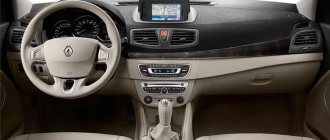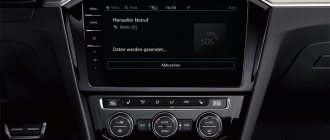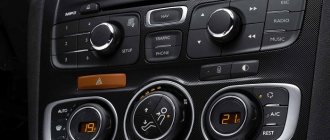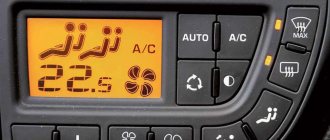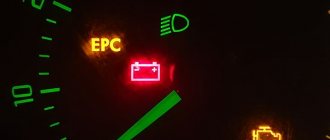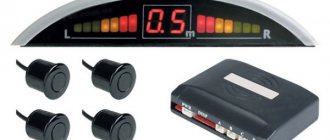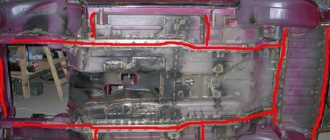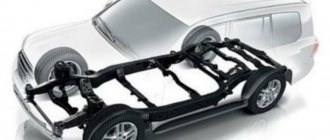Cruise control system, what is it? Option to maintain the selected speed at a certain level without pressing the gas pedal. It can be passive and adaptive. Turns off when you press the brake/accelerator or a special button. Allows you to rest on the road and remove your right foot from the lever. Below we will look in detail at what this option is, how it works, where it is located, and what types there are.
What is cruise control
To use the system correctly, you need to understand what cruise control is in a car. In simple words, this is an additional option that can maintain a certain speed of the car at a level set by the driver. In adaptive systems, it can change depending on the characteristics of the traffic moving ahead. In this case, engine braking occurs or the braking system is activated.
Let's highlight a number of advantages of what cruise control means in a car:
- Possibility of rest during a long trip.
- Availability for installation on cars with automatic or manual transmission.
- Reducing fuel consumption by an average of 5-7%.
- Increased safety for an adaptive distance-keeping system.
Among the disadvantages, it is worth highlighting possible errors in operation, the risk of loss of vigilance due to driver relaxation, and the rise in price of car models with such a system.
Control system
The control systems for passive and adaptive cruise controls have some differences.
In both cases, it is controlled by a small computer that receives data from special sensors. The computer has a connection to the throttle, which it controls.
However, with adaptive devices, the computer still has contact with the ABS and ESP safety systems and works synchronously with them.
What is it needed for
When purchasing a model with this option, you need to understand why cruise control is needed in a car. Its main purpose is to set a certain speed and maintain it over long periods. The machine maintains the set mode even when the wind speed/direction changes, ascent/descent and other factors.
The main purpose is to provide rest for the driver. But there are additional advantages, which were already mentioned above: fuel economy and passive safety.
Precautionary measures
No matter how advanced the electronic device of your car is, remember, cruise control is prohibited from being used when:
- when the road surface is icy;
- when driving on a wet road;
- in case of insufficient visibility (at night, during rain, snowfall, fog).
In the described cases, car manufacturers recommend that drivers take control of the vehicle.
Cruise control has truly made life easier for truckers and road travelers during tedious journeys on smooth and straight roads.
And yet such control cannot be called “unmanned”; be careful! Ask a Question
How does cruise control work?
To understand the features of the system, you need to know how cruise control works on an automatic or a car with a manual transmission. Structurally, the main element is the servo drive, which is connected using a special cable / rod, and is responsible for the fuel supply. So, when the system is turned on, the engine control unit remembers the position of the gas pedal and subsequently maintains the set speed mode.
The operating principle of cruise control is designed in such a way that the ECU monitors the situation, and when obstacles arise (wind, rise), it supplies more fuel to the engine and in this way maintains the set speed. As soon as extraneous factors disappear, the volume of fuel entering the combustion chamber also decreases.
Another bonus that cruise control gives is the ability to maintain a safe speed during long descents. Engine braking occurs, and the normal brakes are not used and do not overheat. But there is a nuance here. On cars with a manual transmission, you may need to switch the speed yourself, and on cars with an automatic transmission this process occurs automatically.
For adaptive systems, a more complex principle works. The improved model includes a radar that records the distance to the vehicle in front. The system also includes a fuse, control panel, vacuum regulator and magnetic sensor. Also involved in cruise control are the brake pedal, speedometer and control unit.
...and disable the traffic control system
This problem is solved in different ways: in some foreign cars it is enough to press the brake pedal, and the car will automatically switch to manual control mode, in other cars you need to press a special lever or button. In addition, if the vehicle has an automatic transmission, then to cancel the motion control function, the lever must be moved to neutral.
IMPORTANT!
If the asphalt on a suburban highway is icy, it is raining heavily, or driving in poor visibility conditions, it is not recommended to turn on cruise control!
What does it look like in the car
Many questions concern the appearance of cruise control, what it is in a car from the point of view of visual definition. Structurally, the system is a group of components that works in conjunction with the engine control unit and the gas pedal.
Beginning car owners often do not know how cruise control is indicated on cars. Externally, it looks like buttons on the steering wheel or special positions on the steering column switch (depending on the model).
Future Application of ACC
A few years ago, Google launched its self-driving car, which relies entirely on autonomous cruise control technology.
Google's self-driving car
This car has a total of eight sensors. Most notable is the Rotating Roof Lidar, a camera that uses an array of 32 or 64 lasers to measure the distance to objects to create a 3D map up to 200m away, allowing the car to analyze potential hazards.
What does it look like in the car
With this in mind, we can conclude what the cruise control button looks like. In different models it may have an individual size and inscriptions. As noted, this can be a set of keys on the car’s multi steering wheel with the inscriptions On, Off, Set / Accel and others. Similar designations can be found on the steering column switches. Knowing what cruise control does in a car, the driver can turn on the system by pressing the On button and selecting a speed. He can make such a decision for rest, fuel economy, safe descent, etc.
Where is the cruise control
Car owners are often interested in where the climate control system is located. If we talk about the main elements responsible for fuel supply, they are located in the engine compartment, but the control buttons are always located in the cabin. With their help you can do the following:
- On—turn on.
- Off - turn off.
- Set / Accel - setting a certain speed / increasing it by 2-5 km/h with each press.
- Resume - return to the previously set speed after a short shutdown.
- Coast - decrease speed.
Knowing why cruise control is needed in a car, you can turn on the system at any time using the On button, and subsequently at any time switch to manual control by pressing the brake / gas or Off to completely deactivate it.
To use cruise control you need to do the following:
- Accelerate the car to the required speed.
- Turn on the system by pressing the On button. At the same time, the corresponding inscription should light up on the dashboard.
- Activate cruise control by pressing the SET key.
- To decrease/increase speed, use the plus and minus icons to change the speed limit by 1-2 km/h.
Additional information for drivers
Checking the passive cruise control system
If the car does not maintain speed when the cruise control system is activated, you need to make sure it is working.
Procedure for checking:
- Turn on the ignition. Turn on the cruise control ON switch. The CRUISE ENGAGED indicator light should light up. The indicator light may be burnt out; if so, it needs to be replaced.
- Press the RES+ button (switch) for 3 seconds. The indicator light should turn on for 3 seconds and go off for 2 seconds. After this, if there is a breakdown, the indicator will display error codes in self-diagnosis mode. If everything is normal, to reset the self-diagnosis mode, you need to speed up to 16 km/h, turn off the cruise control system by pressing the OFF button and make sure that the indicator goes out.
Error codes read using the indicator lamp
When reading, you must remember that:
- there is a long pause between codes;
- two-digit codes are separated by a short pause.
Example, code 12: long flash, short pause, two short flashes.
Error code 01 It is necessary to check the wiring going to the main cruise control buttons, inspect the brake light switch, and check the serviceability of the cruise control brake sensor.
Error code 05 It is necessary to check the fuse and the wiring between the fuse and the cruise control.
Error code 07 You need to check the cruise control brake sensor and brake light switch.
Error code 11 You need to check the cruise control switch.
Error code 12 You need to check the cruise control switch.
How to find out if it is in the car
Many buyers are interested in this option, and they are willing to overpay money for it. To do this, you need to figure out how to find out if your car has cruise control. The work can be done in two ways:
- Look into the interior and look for the presence of buttons on the steering wheel / steering column switch. If they are provided, the system is most likely included in the machine. The only question that remains is whether it works or not.
- View technical specifications. The vehicle parameters for a specific configuration indicate whether the system is provided. Additionally, the operating instructions should contain information about how cruise control is useful, how to use it, and how to turn it on and off.
If the system does not work for some reason, computer diagnostics may be required. In addition, it is often necessary to check the integrity of the fuse, the tightness of the tube from the vacuum reservoir to the brake pedal, the integrity of the wires, the serviceability of the vacuum pump, the integrity of the wires, etc.
Kinds
When considering what cruise control means, it is worth considering the main types of this device. Conventionally, the system is of two types:
- Passive is a classic option, used on cars with manual transmission and automatic transmission for over 40 years. To turn it on, use buttons or special handles on the steering wheel. Disabling occurs when you press the brake or a special button.
- Adaptive - a system that maintains a constant speed and is able to change it taking into account the road situation. If you approach the vehicle in front at a dangerous distance, the speed is automatically reduced.
Adaptive cruise control, in turn, comes in two types:
- Laser. It has a more affordable price, but also serious disadvantages. Thus, the laser hardly works in fog or cloudy weather, and also hardly distinguishes between dirty cars. Radar devices do not have such disadvantages, which is why they are installed on expensive cars.
- Radar (radar) devices are placed behind the radiator grille, send signals and record the distance to the nearest car. If the vehicle slows down or if an additional object appears, the sensor sends a signal to change the speed. This uses not only the engine, but also the brakes. Such a system is more progressive, it is devoid of the disadvantages discussed above and provides greater accuracy of operation of the entire device.
Now you know what a cruise control system is, on what principle it works, and how the car slows down if the speed of the car in front slows down.
In the comments, tell us if such a system is installed on your car, tell us about the features of its operation and share the difficulties you encountered.
Types of device
There are two types of devices under consideration, which are called passive and adaptive. The first option is a classic system that is used on cars with different types of gearboxes for a long period of time. The main function of passive devices lies in maintaining a certain speed of movement.
The adaptive type is the most interesting and in demand, so we will deal with each type separately.
Passive cruise control and its features
The passive type of cruise control has the simplest design, and such a product is used primarily to maintain a certain speed while driving on highways and highways. The design of the passive device includes the following structural elements:
- Control block. The main device that performs calculations while the car is moving when the option is activated.
- Sensors
- Throttle valve actuator or servo.
Passive cruise control package
The device operates quite simply. To do this, you need to go out of town to a highway with good road surface. It is not rational to use this option, both in city traffic and outside the city on roads with poor-quality road surfaces (if there are potholes and other defects on the roads, as well as on primers). As soon as the car reaches a certain speed, which is optimal for a given area, the cruise control is turned on (manually).
After enabling this option, the microprocessor located in the control unit is responsible for the speed of movement. Sensors determine the speed of the vehicle, as well as the throttle position, and transmit information to the control module. When driving conditions change, which can be ascents and descents, the sensors send appropriate signals.
It is important! The sensors do not detect other types of obstacles, so the driver should be careful when the cruise control is on.
As soon as the type of track changes when driving uphill or downhill, the sensors send signals to the control unit. The unit analyzes the signals, after which it sends a command to the servo drive, and the throttle valve closes or opens.
Adaptive cruise control and its features
The adaptive type of cruise control is a new generation of the device. This type of device is used on modern cars, and is intended not only to maintain a certain speed limit, but also to take into account the traffic situation. The traffic situation is taken into account using auxiliary devices: sensors, radars and cameras.
The use of adaptive cruise control makes it possible to link your vehicle to the car moving ahead. The speed of the vehicle ahead is taken into account, and a safe distance is maintained, on the basis of which the control unit controls the vehicle.
Location and overview of adaptive cruise control sensors
If the car moving ahead changes speed, the sensors will send corresponding signals to the ECU. The unit will analyze the signals and make a decision to reduce or increase the speed. If there is no vehicle ahead, the device gives a signal to increase the speed to the required value, after which it maintains it.
This is interesting! There are also cruise control systems that can read road markings. This feature allows the driver to eliminate the need to drive a car.
Adaptive cruise control is designated ACC. This type of system is installed on cars from the factory. The cost of such a system is quite high, due to the use of expensive sensors, cameras and radar. The device also uses a modern control unit, capable of calculating not 2 functions, but several dozen. Depending on the device model, the driver can be notified of an emergency situation ahead by both visual and audio signals.
It is also important to note the fact that the adaptive cruise control system operates in tandem with the ABS anti-lock braking system and ESP. If one of these systems does not function, it will be impossible to activate cruise control. It is recommended to turn on adaptive cruise control when cars are moving at a uniform speed outside the city.
Displaying the adaptive cruise control system on the vehicle's on-board computer
If the vehicle design does not have an adaptive type of cruise control, then its installation does not make justifiable sense. Although this system is more advanced and modern, a passive device is quite sufficient for trips outside the city.


